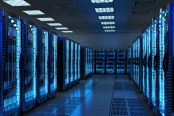There are many different concepts about render farms on the internet, so a lot of people have misconceptions. So, What is a render farm? How many kinds are there? And When should I use a render farm?
A render farm is a high-performance computer system (data center), e.g. a computer cluster, which is specialized in the calculation (rendering) of computer-generated imagery (CGI). It’s mainly used for animations, films, visual effects, as well as architectural visualizations.

At the present time, most people in the industry assume that a render farm is a rendering service that provides powerful computing performance to speed up their rendering.
Kinds of Render Farm
Traditional Render Farm
Traditional Render Farms are usually owned by studios, in which they need to buy computers (render nodes/servers) and licenses for software (creation suite, render farm manager v.v.) in order to build an own render farm, commonly referred to as a Local/In-house render farm. They also have to install, maintain, and take care of everything themselves.
Building a local/in-house render farm has its own pros and cons. On the best side, studios don’t have to worry about security issues as they manage all the data themselves. Moreover, it can be used to render any time they want.
On the other hand, there are quite a lot of drawbacks:
- They will have to fix it themselves if there are any issues.
- It costs a lot of money for investment in machines, licenses, maintenance fees, salary for technical team v.v.
- The investment in machines is limited, at the time when there are many projects or large projects, sometimes the deadline will make them stressful because the number of machines is fixed. If they invest more, at other times, it can be wasteful.
Online Render Farm
An online render farm is quite similar to a traditional render farm, different in that it is publicly accessible as an online service. Customers can send CGI projects to its Local/In-house Render Farm for rendering. Therefore, it has the same pros and cons as a traditional render farm. However, its customer won’t have to take care of a physical render farm.
Cloud Render Farm – The future of render farm
Cloud-based Render Farm also provides an online rendering service, however, it is a render farm based on public Cloud Providers (e.g. AWS (Amazon Web Service), GCP (Google Cloud Platform, Azure (Microsoft Cloud Computing Services)).
This render farm type doesn’t need to take care of infrastructure, so will put more effort into developing the best rendering experience for customers. It takes advantage of the biggest data centers all over the world, which can make it easier to scale up. Customers can submit as many rendering jobs as they need without queues because the number of renderings is no longer limited. All licenses for software have already been set up, and its users just need to upload their projects to our website then submit rendering jobs.
When should I use a render farm?
In the case of simple scenes and short animations where home rendering can be faster than transferring files to render farms, you can render them by yourself. So when should you use a render farm?
- For profitable projects, you need to save your valuable time rather than worrying about rendering
- When rendering animations that require a lot of rendering time
- When you need to speed up your rendering to meet your deadlines
- When rendering complex scenes or high-quality scenes (e.g. 8k, 12k or higher in samples)
- When your computer could not meet rendering requirements
Rendering is just a technical task, so 3D artists shouldn’t spend so much time, instead, they can focus on their creativity.
3S Cloud Render Farm is confident to make rendering much easier for 3D artists. Currently, we support projects using Blender, Houdini, Cinema 4D, Maya, 3ds Max.
Let’s try rendering on our render farm to see how it works!
